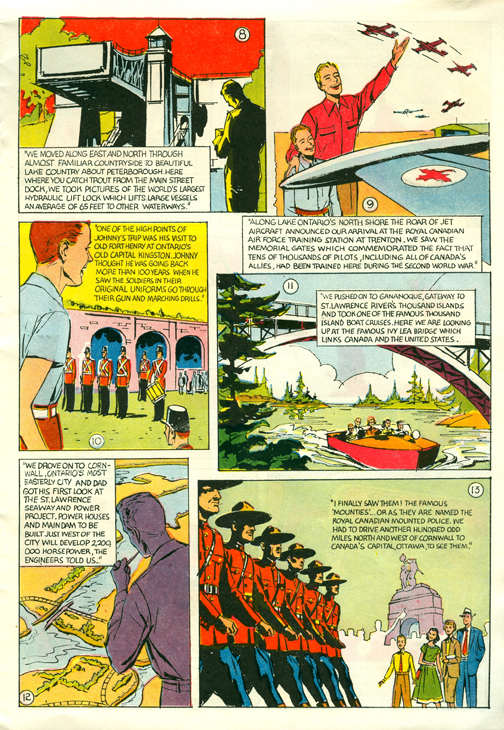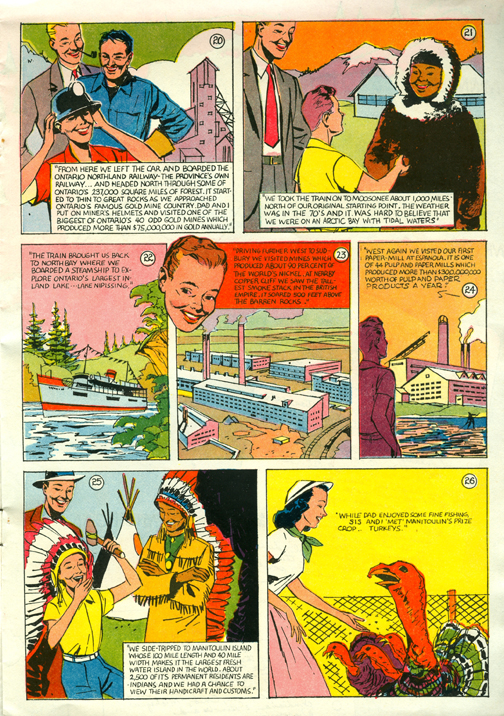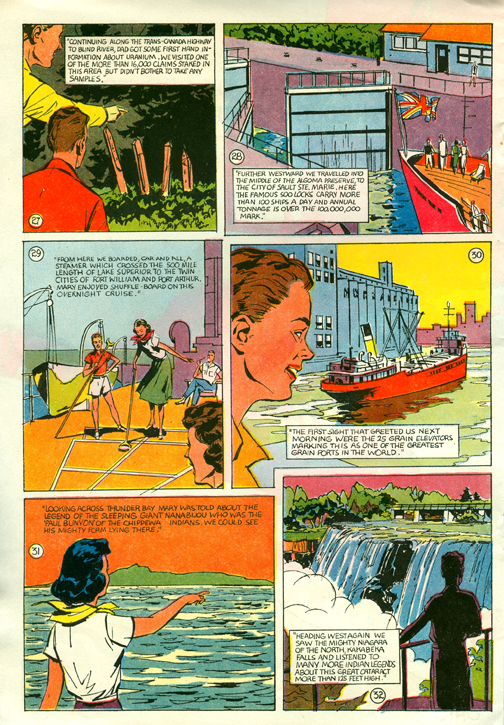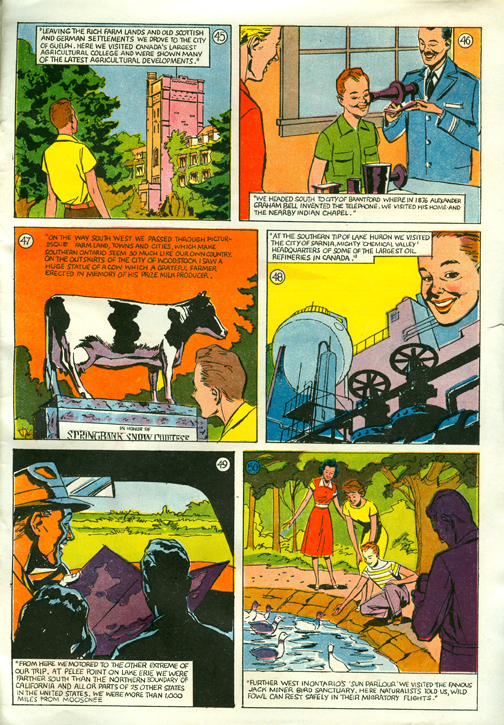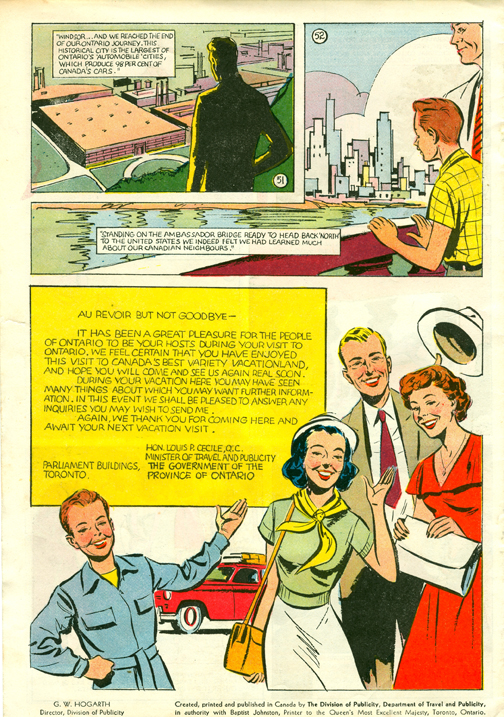Happy 146th Birthday Canada!
146 years ago, after some really crazy make-up sex, the French and English gave birth to a nation of the future.
Canada, you really are aging well. You don’t look a day over 126.

146 years ago, after some really crazy make-up sex, the French and English gave birth to a nation of the future.
Canada, you really are aging well. You don’t look a day over 126.

Natalie Brown was by Valhalla and let me tell you, she’s prettier in person than in any photo or film. That says a lot! After a severe reprimand about having spelled her name incorrectly, Natalie was kind enough to sign her Canadian Culture Thing MapleLeafForever stamp on the back of CCT0113. I had unfortunately projected my French-ness on her Italian-ness (these two of course have nothing to do with Loch-ness) and I added an “H” to her name.
Timmins, Ontario native Natalie Brown (or Nathalie Brun as I like to call her) has appeared in a plethora (that’s right, plethora.) of films, television and commercials. She found her way into pop culture at a young age as the flirtatious Heinz Ketchup girl. From there her modeling career took off and she worked on campaigns for Noxema and Max Factor.
Natalie has appeared in countless films, including How to Lose a Guy in 10 Days (2003) with Kate Hudson and Matthew McConaughey and horror classics like the Dawn of the Dead (2004) and Saw V (2008). Though she has appeared in more TV shows than you can shake a stick at, Natalie starred in the comedy series Sophie (2008-2009).
As the memorable Bailey’s “hot girl”, Natalie Brown inspired TV and movie-goers, to not walk but run, RUN to liquor stores everywhere on chilly winter nights.
In 2010, Natalie appeared as Carol Haplin on the short-lived but super-cool Happy Town. Happy Town was yet another example of an awesome show that got canceled because it was too great for masses to appreciate (et al Firefly, Pushing Daisies, the Tick).
On January 14th Canadian sweetheart Rachel Wilson was by Valhalla and signed her Canadian Culture Thing MapleLeafForever stamp (CCT0106)! She was accompanied by her bombshell friend Bomb Girls’ Ali Liebert (upcoming MapleLeafForever stamp inductee).
Ottawa-born Rachel seems to have been in at least one episode of every show produced between 1994 and the present, as well as having a starring role in an impressive 7 series’. She has also been in such major films like Mystery Alaska, the Glass House and Saw 3D.
But at the core, Rachel might hold a everlasting soft-spot in the hearts of the many fans of Breaker High, the cutting-edge drama of life on a high-school cruise ship…you heard me. Rachel co-starred with Ryan Gosling (upcoming MapleLeafForever stamp inductee) as socially-awkward teenagers trying to make their way in a complicated nineties-high-school-cruise-ship world. Laugh all you want at the premise but remember that Joss Whedon’s Firefly barely aired 11 of it’s 14 episodes before being flatly cancelled while Breaker High boasts a whopping 44 episodes. Disney even set sail on this premise again more than ten years later and managed to produce 4 seasons of another ship-school in the Suite Life on Deck. All of us 40-somethings still remember Square Pegs and it only aired 20 grody-to-the-max episodes.
One on my personal favourite roles was a short film Rachel did in 2009, 75 El Camino. 75 El Camino tells the story of a couple trying to make their way in a complicated lost-my-job-lost-my-house-got-a-case-of-the-cancer story of life, death and El Caminos. Rachel plays the ray of sunshine in her parents struggle while the audience wrestles with the philosophical question: Is it a car? Is it a truck?
75 El Camino – Short Film – Directed by Sami Khan from Kevin C. W. Wong on Vimeo.
Rachel has since starred on racey comedies like Show Me Yours with fellow MapleLeafForever stamp inductee Alberta Watson as well as the religious docu-drama My Pal Satan, historical bio-series the Kennedys and the animated-character Heather on Total Drama Island.
Rachel Wilson has spent the past four years co-starring as fiery Dr. Nikki Renholds on the CBC’s acclaimed Republic of Doyle series.
Attacking Washington during the War of 1812
On August 25 during the third year of the War of 1812, British Troops torched the White House. They also burned the buildings housing the Senate and the House of Representatives along with some other buildings that the Americans hadn’t burned themselves. The campaign was in retaliation to lowly attacks on Canadian citizens and private property along the north shore of Lake Erie in May of 1814.
On August 24th, 1814, a British force led by Major General Robert Ross (not to be mistaken with General “Thunderbolt” Ross who spent many years hunting the Incredible Hulk although no less tenacious) occupied Washington, D.C. and set many fires on controlled targets in the American capitol. Due to the strict discipline of the British troops, private buildings and dwellings were preserved, garnering the respect of much of the American citizenry, while facilities of the U.S. Government were utterly destroyed.
Timing is sometimes everything, and in April of 1814, the Emperor Napoleon had grown tired of conquest and had decided on early retirement on the Island of Elba (even though he grew too bored to stay retired) and he allowed the British to retrieve some troops and redeploy them to the war in the Americas. That and the raised ire against the United States after unruly attacks on the north shore of Lake Erie against Canadian civilians and private property by the American war-machine, the British saw their opportunity to send a message to Washington. While Washington offered no strategic significance, its symbolic message would be heard loud and clear all over the world.
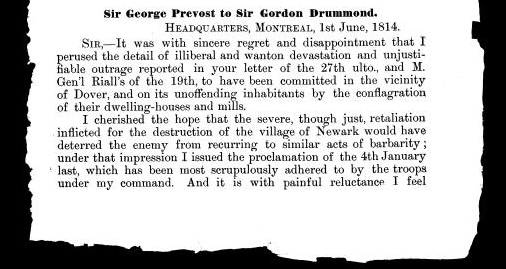

Rear Admiral George Cockburn was given his orders on July 18th to “deter the enemy from a repetition of similar outrages…You are hereby required and directed to destroy and lay waste such towns and districts as you find assailable. However, you will spare merely the lives of the unarmed inhabitants of the United States” (further proof that being unarmed is usually the better choice).
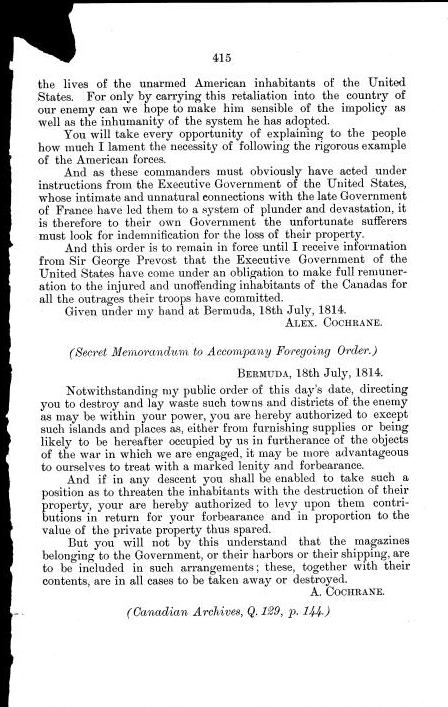

A force of 2,500 soldiers under Major General Robert Ross arrived in Bermuda and then sailed to the Washington area, setting ashore at Benedict, Maryland on August 19 and easily defeating a detachment of U.S. Marines and inexperienced American militia at the Battle of Bladensburg on August 24th.
Immediately, Major General Ross sent soldiers under a flag of truce to agree to terms of the surrender of Washington. Though a civil occupation was attempted, the soldiers were attacked from a house full of partisans. After a quick defeat, the British soldiers burned the house and raised the Union Flag over Washington.
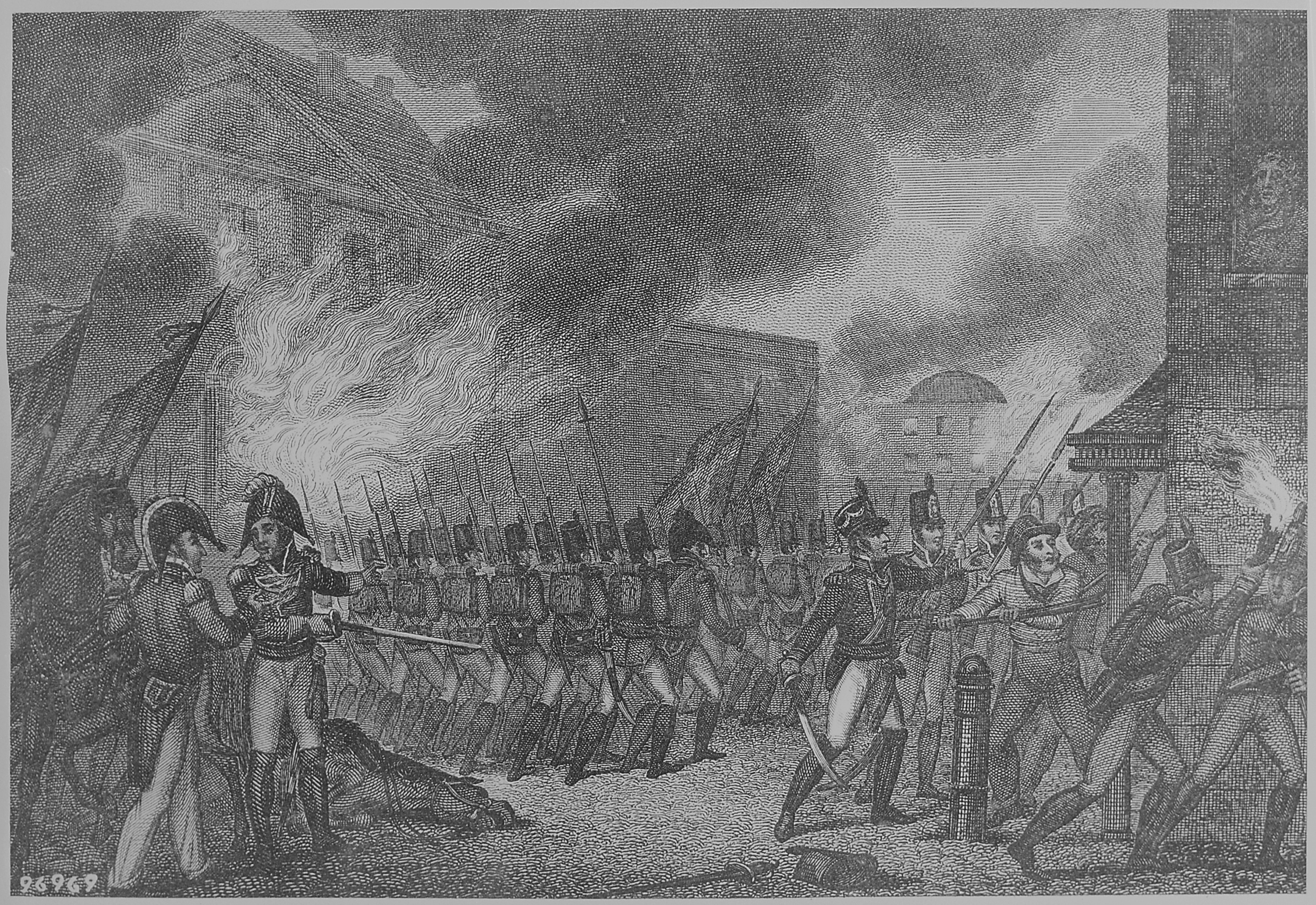
Next, the building that housed the Senate and the House of Representatives were torched and though the torrential rainfall from a passing hurricane preserved the buildings, the Library of Congress contained inside was destroyed.

From there the troops turned northwest up Pennsylvania Avenue toward the White House. During the American retreat, President James Madison sought out his Secretary of War John Armstrong Jr. to see what the plan was for the defence of the capital. Armstrong reported that there was none; he had expected the British to turn near Baltimore. The President, his cabinet and many other government officials fled to the mountains of Virginia. Most residents of Washington had already abandoned the city; preservation of the government’s documents and records had been largely left to clerks and slaves. While the U.S. officials fled, First Lady Dolly Madison remained to pack up the silverware and personal valuables before the arrival of the expected British before fleeing herself.
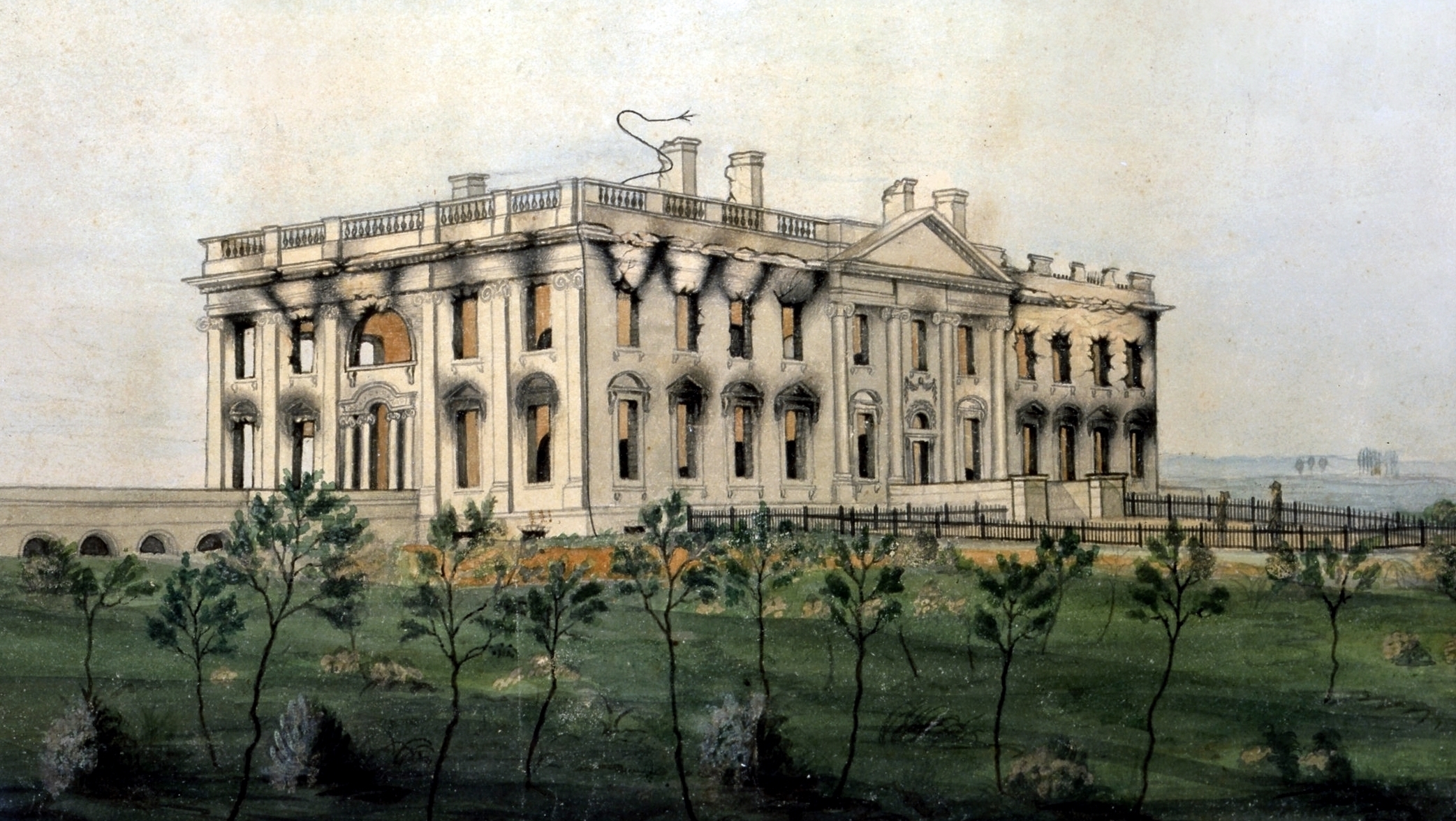
British soldiers added fuel to ensure that the White House (which for a brief time became known as the Black House until it was repainted) would continue burning throughout the rainstorm. It was said that the smoke could be seen as far away as Baltimore. Some even say from as far away as York in Upper Canada.
Continuing to retaliate, Rear Admiral George Cockburn and his troops burned the United States Treasury and intended to set afire the building of the anti-British Washington newsletter, the National Intelligencer but decided against it when a group of women persuaded him not to for fear that the fire would spread to their nearby homes. Cockburn found generosity and lit no fires. Because the paper had been printing disrespectful articles about him, referring to him as a “ruffian” Cockburn now ordered all of the contents of the building to be emptied into the streets and standing on a printing press, he announced that he would destroy all of the letter-C-type “so that the rascals can have no further means of abusing my name.” Instead of burning the building, Cockburn remained a gentleman and ordered his troops to dismantle the building brick by brick.

Less than a day after the beginning of the assault, a sudden and very heavy thunderstorm extinguished most of the fires and a passing tornado put an end to the 26-hour occupation. The British reported one soldier killed and six wounded.
The majority of Britain believed that the burnings were justified following the wonton attacks that Canada had suffered at the hands of the United States forces. Adding that the Americans had been the aggressors, having declared war and initiating aggression towards Canada. Reverend (and eventual Bishop) John Strachan, Rector of St. James Church and future founder of Trinity College, had managed to save the City of York from American soldiers intent on looting and burning it. Strachan had seen firsthand the acts of the American soldiers. He wrote to President Jefferson stating that the damage to Washington “was a small retaliation after redress had been refused for burnings and depredations, not only of public but private property, committed by them in Canada.”

On returning to our sister-country, Bermuda, the British forces arrived with four trophies from their campaign, portraits of the Mad King George III and his wife, Queen Charlotte Sophia. They were found in a warehouse on August 24 or 25, 1814 where they may have been stored since the Revolution. The spoils now hang in Bermuda’s Parliament with a pair in the House of Assembly and a pair at the Cabinet Office of the Bermuda Government.
This was the only time since the Revolutionary War that a foreign power captured and occupied the United States.
Here’s a very cool tourist giveaway comic book I found a short while ago. It was created, printed and published in Canada by G.W. Hogarth and the Division of Publicity, Department of Travel and Publicity, in authority with Baptist Johnston, Printer to the Queen’s Most Excellent Majesty (no pressure) Toronto, Ontario. There is no mention of artist although there could be a signature hiding in a panel somewhere and my guess is it was published circa 1952. If anyone has any additional information, please be sure to let me know.
Reproduced below is the entire comic book of Our Vacation in Ontario, cover to cover.


